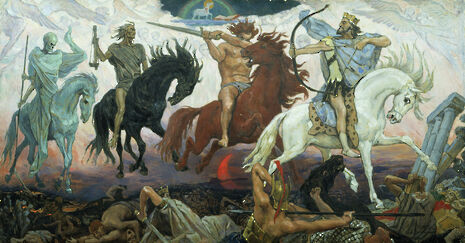Trumpocalypse now?
Arenike Adebajo considers the role and nature of comparisons between Trump’s America and the tropes of popular culture

You know things are bad when the president of the United States sounds a lot like the villain of a Batman movie. Throughout the election, 'Slate' ran a feature called the Trump Apocalypse Watch: a 'subjective daily estimate, using a scale of one to four horsemen, of how likely it was that Donald Trump would be elected president, thus triggering an apocalypse in which we all die.' Unsurprisingly, we’re currently at four horsemen. From the Orwellian doublethink of ‘alternative facts’, to a recent draft of an executive order banning immigration from seven Muslim-majority countries, the outlook for the next four years is bleak.
“On social media, Trump has been figured as various incarnations of the literary villains of childhood: Voldemort, Sauron, Darth Vader.”
Many are looking to pop culture to locate metaphors suitable to describing the current political climate. On social media, Trump has been figured as various incarnations of the literary villains of childhood: Voldemort, Sauron, Darth Vader. It’s been pointed out that Trump’s rise is eerily foreshadowed in the character of Waldo in the TV series Black Mirror. The irreverent cartoon bear rises to power by spewing obscenities and mocking mainstream politicians, becoming a lightning rod for protest voters. Using cultural metaphors is an understandably human response to uncertainty. They act as a way of making sense of these tumultuous times, grounding them in familiar narratives. But as any good English student will tell you, when using metaphors the analysis of the differences between reality and its abstractions is crucial.
Positioning Trump within a cultural narrative of apocalypse is more complicated than we’d like to think. It’s not one sided – Trump himself has used apocalyptic rhetoric to great effect. His inaugural address painted a picture of ‘American carnage’, transfiguring the landscape into one scarred by economic decline and violence, threatened by the Islamophobic conjuring of an amorphous ‘Islamic’ enemy both within and without. The promise to ‘Make America Great Again’ casts Trump as a Messianic figure, personally charged with a prophetic destiny to deliver the nation from perceived catastrophe. It’s nothing new – this seam of rhetoric can be traced back through to the first Puritan settler colonialists, who idealised America as the site of the New Jerusalem promised in Revelations. Or Magneto, if you’re less historically bent.
“Buying into the narrative of Trump as fictive villain is part of the larger complacency that got us where we are now.”
Jay Kuo draws on eclectic popular culture referencesThe Ministry has fallen. Obamadore has left Hogwarts. Bellatrix Conway shrieks lies. Elizabeth McGonnowarren is holding back the Dementors.
- Jay Kuo (@nycjayjay) January 20, 2017
On the other side of the divide, the narrative of the ‘Trumpocalyse’ is palatable because of its seeming simplicity, flattening Trump’s election into a simple case of good vs evil, us vs them. This is the operating mode of the glossy apocalypse of high-budget blockbusters: tsunamis, hordes of zombies, asteroids hurtling towards earth etc. Think 2012 or World War Z. In this scenario, the apocalypse functions as a leveller, with everyone facing up to annihilation together. Those watching are able to viscerally experience the terrors of the carnage on screen, safe in the knowledge that giant wave rearing up to destroy a famous landmark is just excellent CGI.
In an article exploring the very real scenario of a powerful earthquake devastating much of the US’s Pacific North West, Katherine Schultz curtly dubs these apocalyptic visions as “a form of escapism, not a moral summons and still less a plan of action”. There is a distinct difference between comprehending the repercussions of a political event as an abstraction and experiencing them as a lived reality. Buying into the narrative of Trump as fictive villain (Marvel literally released an issue featuring him as a bead-eyed, tiny handed, radioactively xenophobic floating head) is part of the larger complacency that got us where we are now. Consuming Trump’s rise as an apocalyptic event perpetuates simple moral binaries that ignore the fact that many white voters, despite their political leaning, are still implicated in the white supremacist system that got Trump elected and will continue to benefit from their white privilege. This ‘safety-pin’ mentality allows for the signalling of solidarity to become a substitute for action. Trump’s election may be the catalyst for catastrophe, but it is not the sole cause. The toxic white supremacy, Islamophobia, xenophobia, misogyny, transphobia and homophobia which underpinned the Republican victory were threats to the personhood of marginalised people around the world long before the US presidential campaign began.
Although there is a need to interrogate the idea of the Trumpocalypse, this in no way aims to underplay the threat that the new White House administration poses to millions – particularly marginalised groups. Pop culture is still the source of some of the most vibrant and effective means of resistance, and comfort, in the face of an authoritarian state. Feelings of imminent doom have long been galvanising forces in the arts. There is an argument for the trivialisation of serious issues in their comparison to fiction, but the multitude of pop culture references featured on signs in recent protests shows that these narratives do have the power to rally people into effective action. Whether you call Trump a demagogue, a sentient Cheeto, or Darth Vader, what is important now is being an active part of the resistance, not watching and fretting from behind a screen. In the words of the prophetic Gil Scott-Heron, ‘The revolution will not be televised…/The revolution will be live’
 Features / How sweet is the en-suite deal?13 January 2026
Features / How sweet is the en-suite deal?13 January 2026 Comment / Will the town and gown divide ever truly be resolved?12 January 2026
Comment / Will the town and gown divide ever truly be resolved?12 January 2026 News / 20 vet organisations sign letter backing Cam vet course13 January 2026
News / 20 vet organisations sign letter backing Cam vet course13 January 2026 Arts / Fact-checking R.F. Kuang’s Katabasis13 January 2026
Arts / Fact-checking R.F. Kuang’s Katabasis13 January 2026 Music / Inside Radiohead’s circle13 January 2026
Music / Inside Radiohead’s circle13 January 2026








